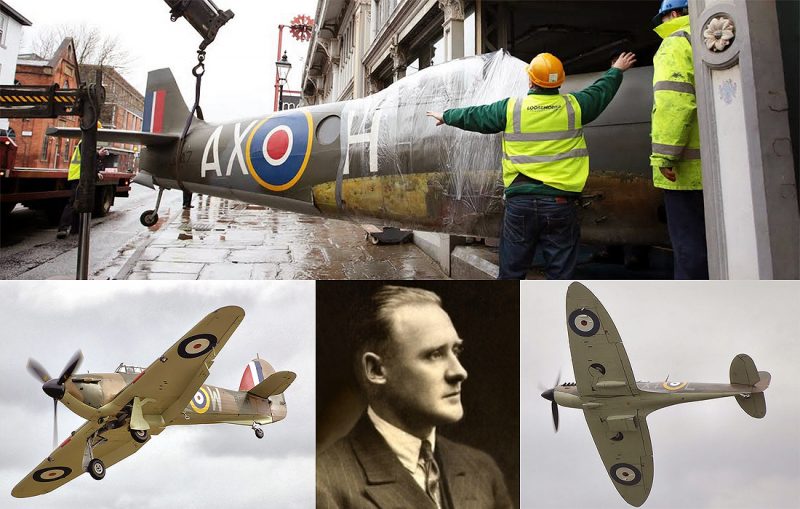Photo story (Clockwise from top left): (1) A surviving Spitfire broken down into smaller pieces to transport it from MOSI to RAF Museum, Hendon on 9th February 2014 (2) The last surviving Spitfire Mk IIa P7350 that fought in the Battle of Britain at Gloucestershire in June 2008 (3) British aeronautical engineer Reginald Joseph Mitchell, the designer of Supermarine S.6B and Supermarine Spitfire (4) Hurricane Mk I (R4118), which also fought in the Battle of Britain, photographed in July 2008
The British single-seated fighter aircraft Supermarine Spitfire was produced in greater numbers than any other British aircraft during the WWII. It first flew on 5th March 1936 and was first introduced on 4th August 1938. Total 20,351 units were built in its production period between 1938 and 1948 and per unit cost in 1939 was £12,604 or $20,969. It was the only British fighter in continuous production during WWII and was used by RAF and many other Allied countries.
British aeronautical engineer R. J. Mitchell, who worked for Supermarine Aviation Works and later for Vickers, designed the Supermarine Spitfire as a high performance, short range interceptor aircraft.
The elliptical wing made it have the thinnest possible cross section and a thus higher top speed than other existing fighters such as the Hawker Hurricane. Until his death from cancer in 1937, Mitchell continued to improve the design. After that his colleague Joseph Smith developed the Spitfire to its variants like Supermarine Seafire and Supermarine Spiteful.
A decisive British victory was achieved during the air campaign waged by Nazi Germany from 10th July 1940 to 31st October 1940 called Battle of Britain. 2,550 serviceable Nazi German aircraft participated in the war. 805 single seated fighters, 224 two seated fighters, 998 medium bombers, 261 dive bombers, 80 coastal aircraft and 151 reconnaissance aircraft were part of the Nazi campaign.
1,963 RAF aircraft participated in British Air Defenses. 754 single seated fighters, 149 two seated fighters, 500 coaster aircraft and 560 bombers were part of the RAF resistance. During this warfare in autumn 1940, Spitfire was perceived by the general public to be the RAF fighter, though the other single seated fighter Hawker Hurricane was more in number than the Spitfire and also shouldered higher proportion of burden against the German Luftwaffe.
But Spitfire units achieved a higher ‘victory to loss ratio’ and suffered fewer damages due to its high performance than Hurricanes.
For the rest of the WWII, the Spitfire became the backbone of RAF Fighter unit superseding the Hurricane and saw actions in European, Pacific, Mediterranean, and South East Asian theaters of the war.
Spitfire was used as interceptor, fighter bomber, photo reconnaissance and trainer. It was much loved by the pilots who flew it. A 1,030 hp or 768 kW Rolls Royce Merlin engine was used in a Spitfire until the 2,340 hp or 1,745 kW Rolls Royce Griffon engine was used in operational 41 Squadron in April 1943. Spitfire retired in 1961 from its last services at Irish Air Corps. But it still continues to be a very popular aircraft, with around 50 Spitfires still airworthy and many more are at static exhibits in different aviation museums around the world.
Online edition of regional daily newspaper published in Manchester in the UK, The Manchester Evening News reported that a surviving Spitfire FR Mk.XIVe MT847 was broken down into smaller pieces to transport it from the Manchester Museum of Science and Industry (MOSI) to RAF Museum located at Hendon suburb in London on 9th February 2014.
It was operated by RAF 613 squadron from 1946 to 1948 and has been on display at the MOSI at Liverpool Road venue for 19 years and drew lots of attraction in the Air and Space hall since 1995. It was being taken to Hendon RAF Museum for an exhibition titled ‘Britain from Above’.
It was seen without its propeller and wings while it was hauled out of the Museum by a crane. It was on loan from RAF museum and has now been returned duly. MOSI said that two months of planning was required for the shifting of the Spitfire and the road outside also needed to be shut. It took four days to dismantle the fighter from end to end and wing by wing.
http://www.youtube.com/watch?v=dW7bzlXuiq8
Video story: Documentary on WWII Supermarine Spitfire fighter aircraft
